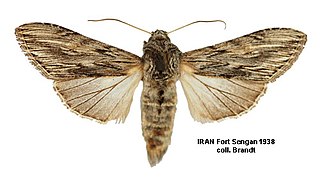
The Noctuidae, commonly known as owlet moths, cutworms or armyworms, are the most controversial family in the superfamily Noctuoidea because many of the clades are constantly changing, along with the other families of the Noctuoidea. It was considered the largest family in Lepidoptera for a long time, but after regrouping Lymantriinae, Catocalinae and Calpinae within the family Erebidae, the latter holds this title now. Currently, Noctuidae is the second largest family in Noctuoidea, with about 1,089 genera and 11,772 species. However, this classification is still contingent, as more changes continue to appear between Noctuidae and Erebidae.

Lygephila lusoria is a moth of the family Erebidae. The species was first described by Carl Linnaeus in his 1758 10th edition of Systema Naturae. It is found in southern Europe, the Near East and Middle East, European south-eastern Russia, the Caucasus, Turkey and Israel.
Armada panaceorum is a moth of the family Noctuidae first described by Édouard Ménétries in 1848. It is found in the arid parts of North Africa, the Near East and the Middle East, Kazachstan, eastern Afghanistan, Mongolia, Tibet and south-eastern Turkey.

Catocala puerpera is a moth of the family Erebidae first described by Michel-Esprit Giorna in 1791. It is found in Mediterranean and sub-Mediterranean areas of the Near East and Middle East and in North Africa.
Heteropalpia profesta is a moth of the family Noctuidae first described by Hugo Theodor Christoph in 1887. It is found in the Near East, the Middle East, Iraq, Iran, Afghanistan, Transcaucasia, Turkmenistan and the Arabian Peninsula.

Simyra dentinosa is a moth of the family Noctuidae. It is found in south-eastern Caspian, Balkans, southern part of Eastern Europe, the Near East and Middle East. It has been introduced in the United States.
Hadena silenes is a species of moth of the family Noctuidae. It is found in Europe, Turkey, Israel, Iran and Turkmenistan.

Cucullia boryphora is a moth of the family Noctuidae first described by Gotthelf Fischer von Waldheim in 1840. It is found in the semi-arid and xeromountain areas of the Near East and Middle East, from the European part of southern Russia to Turkestan, the western Himalayas, Afghanistan, Iran, Saudi Arabia and United Arab Emirates.

Shargacucullia blattariae is a moth of the family Noctuidae. The species was first described by Eugenius Johann Christoph Esper in 1790. It is found in south-eastern Europe, the Near East, Israel and Jordan.
Shargacucullia barthae is a moth of the family Noctuidae first described by Boursin in 1933. It is found in Turkey, Iraq, Iran and the Near East.
Metalopha liturata is a moth of the family Noctuidae. The species was first described by Hugo Theodor Christoph in 1887. It is widespread but local in the Near East and Middle East from the Levant area to the western Himalayas.
Calophasia barthae is a moth of the family Noctuidae. The species was first described by Wagner in 1929. It is found in the southern part of the Balkans, Turkey and the Middle East.
Pamparama acuta is a moth of the family Noctuidae first described by Christian Friedrich Freyer in 1838. It is found in Asia Minor and the Near East.
Cleonymia chabordis is a moth of the family Noctuidae. The species was first described by Charles Oberthür in 1876. It is found in North Africa, the Near East and Middle East, the Arabian Peninsula, Iran, Jordan and Israel.
Metopoceras omar is a moth of the family Noctuidae first described by Charles Oberthür in 1887. It is widespread through the Palearctic eremic (desert) zone from north-western Africa to the Near East and Middle East.
Metopoceras solituda is a moth of the family Noctuidae first described by Brandt in 1938. It is found in the eremic (desert) parts of Africa, north to south-western Iran and the Near East, where it occurs in Saudi Arabia, the Sinai in Egypt, Israel, Jordan, Lebanon and Syria.

Chazaria incarnata is a species of moth of the family Noctuidae. It is found on the Canary Islands and on the Iberian Peninsula, east to Italy, Serbia, Romania, Bulgaria, North Macedonia and Greece. Further east it is found to southern and eastern Russia in the north and Turkey, the Dead Sea region of Israel and Iran.

Euxoa aquilina is a moth of the family Noctuidae. It is found in the Mediterranean region of Europe, North Africa, the Near East and the Middle East.

The Erebidae are a family of moths in the superfamily Noctuoidea. The family is among the largest families of moths by species count and contains a wide variety of well-known macromoth groups. The family includes the underwings (Catocala); litter moths (Herminiinae); tiger, lichen, and wasp moths (Arctiinae); tussock moths (Lymantriinae), including the arctic woolly bear moth ; piercing moths ; micronoctuoid moths (Micronoctuini); snout moths (Hypeninae); and zales, though many of these common names can also refer to moths outside the Erebidae. Some of the erebid moths are called owlets.

The Erebinae are a subfamily of moths in the family Erebidae erected by William Elford Leach in 1815. Erebine moths are found on all continents except Antarctica, but reach their greatest diversity in the tropics. While the exact number of species belonging to the Erebinae is not known, the subfamily is estimated to include around 10,000 species. Some well-known Erebinae include underwing moths (Catocala) and witch moths (Thermesiini). Many of the species in the subfamily have medium to large wingspans, up to nearly 30 cm in the white witch moth, which has the widest wingspan of all Lepidoptera. Erebine caterpillars feed on a broad range of plants; many species feed on grasses and legumes, and a few are pests of castor bean, sugarcane, rice, as well as pistachios and blackberries.









